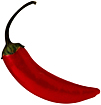 |
A Hot Sauce Guide Takes A Stand Against Bland!
|
 |
|
HOT SAUCE 101 Torrid Times Heat & Health How Hot Is Hot? The Big Chill Hall of Flame Global Warming Chile Peppers |
|||||||||||||
Chile Pepper ProfilesA pepper by any other name would be as hot and probably more accurate than calling it a "pepper." Blame it on Christopher Columbus. When he discovered the New World and its fiery pepper plants, he thought the plant was a relative of black pepper. We still call peppers, peppers although we usually append the term "chile" to differentiate it from black pepper. "Chile," though, also has its set of spelling problems. You can spell it "chilli," or "chile." Usually people refer to "chile" when they mean the hot pepper and "chili" when referring to the stew (a mixture of meat, chiles and beans). Pepper Notes: Here's how to pick a proper chile pepper: Fresh is best. Fresh chiles should be dry, firm, unwrinkled and relatively heavy. (If they're light, they are dried out.) Can't find fresh, frozen will do. It can be hard to find frozen peppers, so feel free to buy fresh and then freeze the leftovers. Canned chiles are okay for cooked dishes, but generally carry less kick than fresh chiles and are mushy so they're not as good served alone (see Canning Chiles and Sauces). The color of many popular chile peppers will tell you how ripe they are. Green chiles are merely unripe peppers. Ripe chiles can be red, yellow, orange and even brown. Size is no indication of spiciness. Sometimes a lot of heat can be packed in a small package like a habanero or a teeny Thai pepper. That said, the broader the "shoulders" of the pepper, generally the more mild. That's why your garden variety green peppers are very mild and jalapenos, with their perfectly round tops, are hot (see Jalapeno Madness). Can't find canned or fresh? You can buy dried peppers which have concentrated flavor and heat. In fact, chile powder is ground up dried chiles with other spices, such as cumin, added to round out the taste. To store fresh chiles, just place them in the refrigerator. At the most, wrap a dry paper towel around them. They can last up to 14 days like this, although it's generally better to consume within a week of purchase (see Produce - The Safe Way). Do not store in a plastic bag where moisture (and mold) can build up. You can try drying your own, but generally you need extremely low humidity and a commercial dehydrator to get the best results. |
|||||||||||||
|
A division of Sparky Boy Enterprises Copyright © 2006. All rights reserved. |
|||||||||||||




